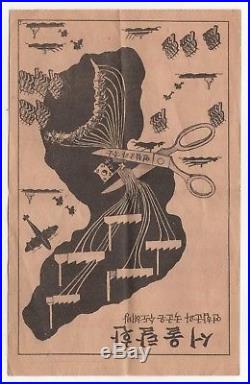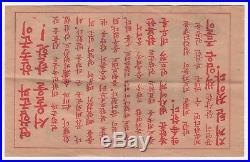Rare Original KOREAN WAR Leaflet FLYER Propaganda KOREA PSYOP Military US ARMY



Rare original 5" x 8" propaganda leaflet from the Korean War; one side features text in Korean and the other features a map of the Korean peninsula with a scissors. There are fold lines and some edgewear. Psychological operations were used extensively during the Korean War.
The first unit, the 1st Loudspeaker and Leaflet Company, was sent to Korea in fall 1950. [19][20] Especially for the operations directed against troops of the Democratic Republic of Korea (DPRK; North Korea), it was essential to work with Republic of Korea (ROK; South Korea personnel) to develop propaganda with the most effective linguistic and cultural context. Since the war was a United Nations mandated operation, political sensitivities were high.
While rules limited mentioning the Peoples Republic of China or the Soviet Union, first due to fear it would increase their intervention, and later because it might demoralize ROK civilians, Stalin was depicted and Chinese troops were targeted in leafleting. Various methods were used to deliver propaganda, with constraints imposed by exceptionally rugged terrain and that radios were relatively uncommon among DPRK and PRC troops. Loudspeaker teams often had to get dangerously close to enemy positions. Artillery and light aircraft delivered leaflets on the front lines, while heavy bombers dropped leaflets in the rear. Over 2.5 billion leaflets were dropped over North Korea during the war.
[19] There was a somewhat artificial distinction made between strategic and tactical leaflets: rather than differentiating by the message, tactical leaflets were delivered within 40 miles (64 km) of the front lines and strategic leaflets were those delivered farther away. Less direct and immediate correlation between tactical PSYOP efforts and target audience behavior may still be substantiated after the fact, especially by means of polling and interviews.For example, in the Korean War, approximately one-third of the total prisoner of war (POW) population polled by the United Nations (UN) forces claimed to have surrendered at least in part because of the propaganda leaflets. The contributions of PSYOP in the first Persian Gulf War have also been corroborated through POW interviews. Ninety-eight percent of the 87,000 POWs captured either possessed or had seen PSYOP leaflets that provided them with instructions on how to approach U. Fifty-eight percent of the prisoners interviewed claimed to have heard coalition radio broadcasts, and 46 percent believed that the coalition broadcasts were truthful despite coming from their enemy.
Again, some portion of the surrenders might have occurred even without PSYOP encouragement; but certainly, there would appear to be a correlation between PSYOP, which offered the enemy a way to escape the onslaught of U. Military power, and their compliance with those instructions. One such operation, is Operation Moolah. The objective of the psychological operation was to target Communist pilots to defect to South Korea with a MiG-15, in order for the U. To conduct analysis of the capabilities of the MiG. Some leafleting of North Korea was resumed after the Korean War, such as in the Cold War Operation Jilli from 1964 to 1968. The Korean War (in South Korean Hangul: ; Hanja: ; RR: Hanguk Jeonjaeng, "Korean War"; in North Korean Chosn'gl: ; Hancha: ; MR: Choguk haebang chnjaeng, "Fatherland Liberation War"; 25 June 1950 27 July 1953)[36][b][38] was a war between North Korea (with the support of China and the Soviet Union) and South Korea (with the principal support of the United States).The war began on 25 June 1950 when North Korea invaded South Korea[39][40] following a series of clashes along the border. [41][42] The United Nations, with the United States as the principal force, came to the aid of South Korea. China came to the aid of North Korea, and the Soviet Union also gave some assistance to the North.
Korea was ruled by Imperial Japan from 1910 until the closing days of World War II. In August 1945, the Soviet Union declared war on Imperial Japan, as a result of an agreement with the United States, and liberated Korea north of the 38th parallel.
Forces subsequently moved into the south. By 1948, as a product of the Cold War between the Soviet Union and the United States, Korea was split into two regions, with separate governments. Both claimed to be the legitimate government of all of Korea, and neither accepted the border as permanent. The conflict escalated into open warfare when North Korean forcessupported by the Soviet Union and Chinamoved into the south on 25 June 1950.
[43] On 27 June, the United Nations Security Council authorized the formation and dispatch of UN forces to Korea to repel what was recognized as a North Korean invasion. [44] Twenty-one countries of the United Nations eventually contributed to the UN force, with the United States providing 88% of the UN's military personnel.After the first two months of war, South Korean and U. Forces rapidly dispatched to Korea were on the point of defeat, forced back to a small area in the south known as the Pusan Perimeter. In September 1950, an amphibious UN counter-offensive was launched at Incheon, and cut off many North Korean troops.
Those who escaped envelopment and capture were forced back north. UN forces rapidly approached the Yalu Riverthe border with Chinabut in October 1950, mass Chinese forces crossed the Yalu and entered the war. [43] The surprise Chinese intervention triggered a retreat of UN forces which continued until mid-1951. After these reversals of fortune, which saw Seoul change hands four times, the last two years of fighting became a war of attrition, with the front line close to the 38th parallel. The war in the air, however, was never a stalemate. North Korea was subject to a massive bombing campaign. Jet fighters confronted each other in air-to-air combat for the first time in history, and Soviet pilots covertly flew in defense of their communist allies. The fighting ended on 27 July 1953, when an armistice was signed. The agreement created the Korean Demilitarized Zone to separate North and South Korea, and allowed the return of prisoners. However, no peace treaty has been signed, and according to some sources the two Koreas are technically still at war.As a war undeclared by all participants, the conflict helped bring the term "police action" into common use. It also led to the permanent alteration of the balance of power within the United Nations, where Resolution 377passed in 1950 to allow a bypassing of the Security Council if that body could not reach an agreementled to the General Assembly displacing the Security Council as the primary organ of the UN. Thank you for looking at our items! Chestnut Hill Books ships to every country in the world at reasonable rates as suggested by the United States Postal Service.
Postcards are mailed between sturdy cardboard. We strive to describe each item completely and accurately.
Should you have any question about the condition or representation of your item. Chestnut Hill Books is a family-owned antiques business based out of the SouthCoast, Massachusetts.
We collect historical items related to New Bedford, Massachusetts and the surrounding area (Dartmouth, Fairhaven, Westport etc), Boston College (tickets, programs, pennants, postcards, scrapbooks, pinbacks, sports & non-sports etc), Massachusetts political buttons & memorabilia and Mount Monadnock in Jaffrey, New Hampshire. We normally respond to all inquiries in a timely manner. Thank you for looking at our listings! The item "Rare Original KOREAN WAR Leaflet FLYER Propaganda KOREA PSYOP Military US ARMY" is in sale since Tuesday, January 16, 2018. This item is in the category "Collectibles\Militaria\Korea (1950-53)\Original Period Items".The seller is "chestnuthillbooks" and is located in New Bedford, Massachusetts. This item can be shipped worldwide.
- Type: Leaflet
- Theme: Military
- War: Korean
